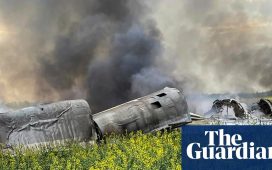In a speech ahead of the upcoming one-year anniversary of Russia’s invasion of Ukraine, President Vladimir Putin announced the suspension of Russia’s participation in the New Strategic Arms Reduction Treaty, known as New Start.
“They want to inflict a strategic defeat on us and claim our nuclear facilities,” said Putin. “In this regard, I am forced to state that Russia is suspending its participation in the strategic offensive arms treaty.”
However, the foreign ministry later said Moscow intended to continue abiding by the restrictions outlined in the treaty on the number of warheads it can have ready.
Those decisions were taken in order to “maintain a sufficient degree of predictability and stability in the nuclear missile sphere”, the ministry said in a statement.
What is New Start?
Signed by then US president Barack Obama and his Russian counterpart, Dmitry Medvedev, in 2010, the New Start treaty caps the number of strategic nuclear warheads that the United States and Russia can deploy. Together, the US and Russia own 90% of the world’s nuclear weapons.
In this context, “deploy” means ready for immediate use, rather than have in storage. Weapons kept in storage are “non-deployed”. According to an explainer of the treaty written by the EU parliament, “Warheads count as deployed if loaded onto a missile that is itself deployed”.
Under the agreement, Moscow and Washington are committed to deploying no more than 1,550 strategic nuclear warheads and a maximum of 700 long-range missiles and bombers. Each side can conduct up to 18 inspections of strategic nuclear weapons sites every year to ensure the other has not breached the treaty’s limits.
The treaty came into force in 2011 and was extended in 2021 for five more years after Joe Biden took office.
Inspections under the agreement were put on hold in March 2020 because of the Covid pandemic. Talks between Moscow and Washington on resuming inspections were due to take place in November last year in Egypt, but Russia postponed them. Neither side has set a new date.
What are the implications of a suspension?
While the foreign ministry has said it would continue abiding by the treaty’s restrictions, a suspension of the treaty may mean that it will be harder for the US to monitor compliance.
Russia has already suspended mutual inspections of nuclear weapons sites and participation in a bilateral consultative commission. Experts say it would be a serious blow if Putin went further and stopped routine reporting and data exchange on nuclear weapon movements and other related developments.
John Erath, senior policy director for the Center for Arms Control and Non-Proliferation, said in an interview with the Washington Post that the move is “entirely symbolic”.
He believes that Putin made the announcement to pressure Biden into approaching Russia about ending the war, “so Russia can dictate the terms under which that would happen”.
Andrey Baklitskiy, a senior researcher at the weapons of mass destruction and other strategic weapons programme at the UN Institute for Disarmament Research, told the Guardian the suspension was, “a big deal; suspension of the treaty is not equal to withdrawal but in reality, it could become really close over time”.
He said that now, “Russia will probably stick to the New Start treaty limits,” but that it will “be harder for the US to verify compliance only using the national technical means. And I would expect the US also suspending its obligations.
“One silver lining is that Russian decision is political and can be easily reversed if the overall political relations change,” he added. “Also, since the treaty exists, getting back to implementation would be straightforward. The problem, of course, is that there is no change of political relations in sight.”














